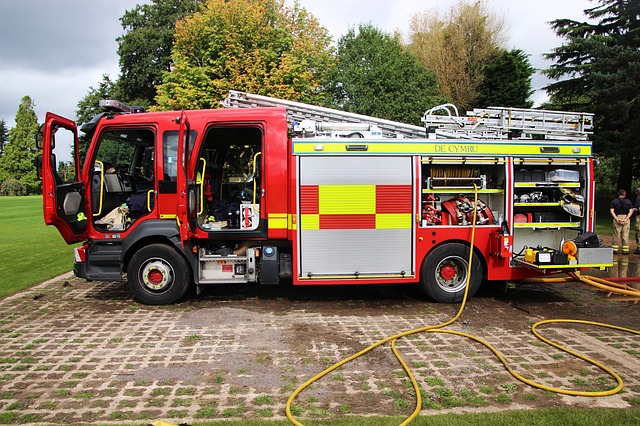By Tim Lambert
Early Firefighting
Fires were a major hazard in the past when towns were crowded and houses were often made of wood. Worse roofs were often thatched. In the Middle Ages, thatched roofs were banned in London because of the risk of fire. In smaller towns, thatched roofs were not banned till much later. In Chichester, they were not banned till 1687.
The first fire brigade was formed in Rome in 6 AD. Roman firemen were called vigeles. They used buckets of water passed from man to man. They also had axes and long hooks to pull down buildings and make fire breaks. However, Rome suffered a severe fire in 64 AD.
After the fall of Rome in the 5th century, there was no organised firefighting in Europe for centuries. In Medieval towns fire was a constant danger because houses were very often made of wood and roofs were often thatched. In London, thatched roofs were banned in 1212 to try and reduce the risk of fire but it had little effect. London suffered devastating fires in 798, 982, and 989. However, the worst fire in London was in 1666. In 1675 half of the houses in the town of Northampton were destroyed by fire.
In the mid-17th century the only tools for fighting fire were buckets, hooks, and handheld pumps. (Gunpowder could be used to blow up buildings and create fire breaks).
However, in 1672 Jan Van der Heiden invented a flexible leather hose with brass fittings. Van der Heiden also pioneered hand-pumped fire engines to use with the hose. An improved fire engine was made by Richard Newsham in 1721. The early fire engines could be pulled to the scenes of fires by horses and they made firefighting much more effective.
In the late 17th century and the 18th century fire insurance companies employed their own firemen. Customers had metal fire marks on the walls of their houses to show the name of their insurance company. Firemen would do nothing to help if your house was on fire unless you had a fire mark showing you were a customer of their company.
Modern Firefighting
The modern fire extinguisher was invented by George William Manby in 1819. As early as 1784 a man named Daniel Maseres invented a form of fire escape. George Huttman and George Kornelio patented a wagon-mounted fire escape in 1849. By the 1870s fire escapes were common on buildings.
During the 18th century and 19th century, brigades of volunteer firemen were formed in many towns. They operated alongside the insurance company firemen.
Meanwhile, the first municipal fire brigade was formed in Edinburgh in 1824. It was led by a man named James Braidwood. In 1832 he was persuaded to move to London to lead a force of professional firemen called the London Fire Engine Establishment. The new fire brigades were very effective although Braidwood himself was killed in a fire in 1861. In 1866 the Metropolitan Fire Brigade was formed.
From the 1850s powerful steam, pumps were used to fight fires. Another change came with the invention of the internal combustion engine. From 1904 petrol-driven fire engines were used. Meanwhile, steam pumps were mounted on platforms floating on the River Thames. At first, tugs pulled them to fires on the river but in 1898 the first self-propelled fireboat was launched.
Despite improvements in firefighting in the 19th century Chicago was devastated by fire in 1871.
Meanwhile with the Industrial Revolution buildings were becoming higher. In the late 19th century fire brigades in Britain used wheeled escapes. They were ladders carried on horse-drawn vehicles that could be extended to 50 feet long. In 1906 the turntable ladder was invented.
In 1939 the government realized that the German bombing would cause a huge number of fires and extra help was needed. So they formed the Auxiliary Fire Service. They were desperately needed especially as the Germans dropped many incendiary bombs.
In 1965 Duane D Pearsall invented the battery-powered smoke detector. In 1976 Mary Langdon became the first female firefighter in Britain. In 1996 Fleur Lombard became the first British female firefighter to be killed in the line of duty.
Recently thermal imaging cameras have become a useful tool for firefighters.

Last revised 2024